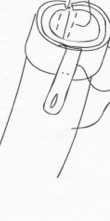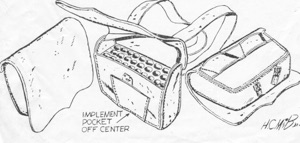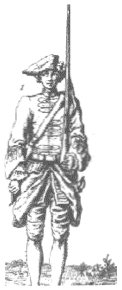


The clothing, weapons and equipment we use are based on extensive research and analysis of historical records and documents pertaining to the Régiment de Saintonge during the period from 1780 to 1781. We strive to be as historically accurate and authentic as possible, and due to the distinctive nature of the clothing and equipment of the Régiment de Saintonge, nearly all of our clothing and equipment must be made by the men and women of the Regiment.
The principal pieces of clothing and accessories of a soldier of the French line are briefly described below. To field as a member of the 85ème Régiment, you will need the items listed below. There are different requirements for women, and for men portraying the 4th Middlesex Militia — we can help with civilian outfitting.
Hat. A black cocked hat that is nearly a bi-corn, trimmed with black tape and decorated with the “Alliance” cockade, a black American cockade over a white French cockade, above a small brass regimental button.
Waistcoat. A white waistcoat with a green stand-up collar and green cuffs, brass regimental buttons and long sleeves without gussets to close the armpit.
Breeches. White breeches reaching just below the knee with a “broad” fall front opening and a five-button closure at the knee, all with cloth-covered buttons.
Gaiters. White (for parade or battle) or black (for marching and fatigue duty) gaiters nearly cover the shoe and reach above the knee.
Regimental Coat. The most distinctive element of a soldier’s outfit, the regimental coat is made of white wool with green wool facings and sleeve cuffs and brass regimental buttons. The coat identifies its wearer as a member of the fusilier (battalion or “hat”) company, grenadier company or chasseur (similar to light infantry) company through differences in epaulettes and insignia on the turnbacks (fleur de lis for fusiliers, flaming grenade for grenadiers and hunting horn for chasseurs).
Cartridge Box/Bayonet Scabbard. One of the soldier’s most important pieces of equipment, the cartridge box held the soldier’s paper cartridges, keeping them safe from damage from weather or handling. The black rough-out leather box is suspended from a white leather strap that has a strap and button mounting to retain the bayonet scabbard.
Swords. All lower officers, members of the Grenadier and Chasseur companies, and musicians carry the Model 1767 French infantry sword.
Musket. Appropriate commercially available reproduction muskets include the Model 1766 “Charleville” and the Model 1777 “Saint Etienne” muskets.
In addition to the clothing and equipment described above, you will need several other items, and other items will make your days (and nights) more comfortable. First, you will need to wear shoes of some kind. Because the gaiters worn by the French army cover most of the shoe, it is possible to wear plain-toe black leather shoes under the gaiters without visibly detracting from the regiment’s presentation. You will probably also want a haversack, a linen or canvas shoulder bag used by people in the 18th century to carry food rations and other personal items; this may be made or purchased — sources are listed below. Finally, you may need period-appropriate eating and camping equipment.
*Our thanks to the “Discriminating General” for the Drill GIF.